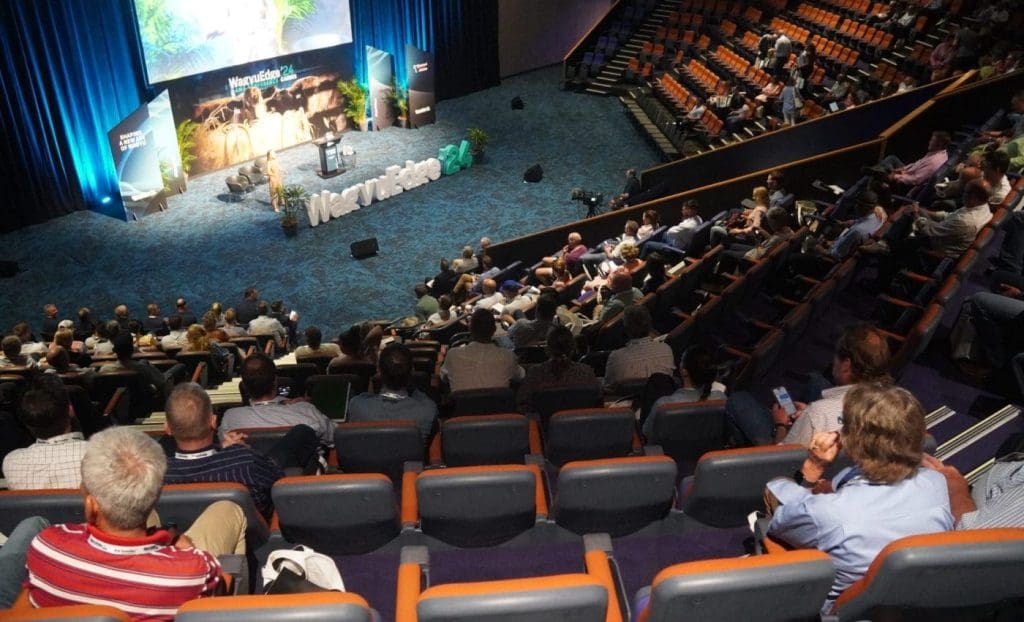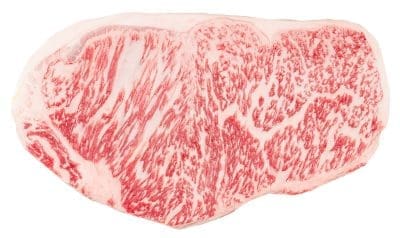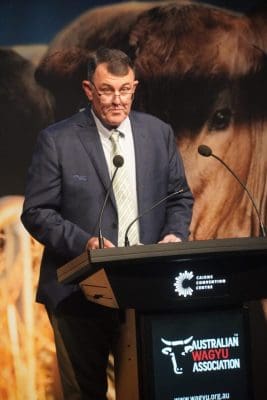
Some of the 650 delegates gathered in Cairns this afternoon for the 2024 Wagyu Conference
WHILE international markets for high quality marbled beef remain flat, F1 Wagyu cattle heading to slaughter this week after completing a typical 380-day feedlot program still bear the shadow of feeder steer purchases made back in early 2023 of at least 800c/kg, liveweight.
It’s a graphic example of the considerable challenges faced by the Wagyu industry, where extremely long production cycles represent substantial financial risk and uncertainty.

Click on image for a larger view. Click twice for an even larger view
At their peak during the last ‘boom cycle’ in late 2022, F1 Wagyu feeders reached 980-1050c/kg liveweight for well-bred F1 examples, market participants told Beef Central. But by November last year, good F1 Wagyu feeders were worth only 330-350c/kg – about one third of their price seen the same time the year before.
Today, market participants say Wagyu F1 feeders are making anywhere from 410c to 440c/kg ex Downs, depending on quality. But the meat harvested from those animals will not find its way into a restaurant in Shanghai, Seoul or San Francisco until at least August or September, 2025.
Australian Wagyu supply chains say they often hear from customers overseas remarking on reports about the greater availability and lower prices for Wagyu feeders, asking why meat prices aren’t lower, as a result.
“They either don’t understand, or don’t like to think that it takes more than a year from the feeder buy price to the time that carton of marbling score 8 or 9 striploins arrives in their coldroom,” one contact said.
“Since the last quarter of last year and into the early stages of 2024, Wagyu beef prices have been horrendous, and bear no resemblance to the input costs,” he said.
“A typical Wagyu or Wagyu cross animal leaving the feedlot this week for slaughter has probably cost its owner between $4500 and $5000 to produce (livestock purchase plus feed and management costs). That puts a lot of pressure on for marbling performance, to even get close to breaking even.”
Some Wagyu export markets, like Korea, had declined substantially, due to the liquidation of the country’s domestic Hanwoo herd, while China was currently a very flat market for high quality beef. Other markets like Japan and southeast Asia were mixed, he said.
“Global consumer wariness about discretionary spending hasn’t helped, and each export market has had its own issues,” he said.
“if you’re producing 100-day beef, you have a pretty fair idea what demand will be like in three or four months when the cattle come out. With Wagyu, you are looking over the horizon – it’s an industry largely based on speculation, about what demand for high-priced beef will be like in 15 or 18 months’ time.”
“As a result, supply chains just meet the market for Wagyu feeder cattle, and retain some optimistic expectation that the meat market will be at a certain point when it comes time to sell the beef.”
Conference attracts big numbers
Topics like these will come into sharp focus during the Wagyu Edge 2024 conference being held in Cairns from today.

AWA President Laird Morgan addressing the opening session of the 2024 AWA conference this afternoon
About 650 delegates from all over Australia, New Zealand and other countries are arriving for the conference – the biggest ever staged, with about 200 new faces in attendance. It makes the Wagyu conference arguably the largest annual beef industry event in the nation.
Wagyu now represents ten percent of the Queensland beef herd, and accounted for exports worth $2 billion last year, delegates were told.
Beef Central will file reports from the event in coming days.
High feed costs add to burden
It has been a tough for years for Wagyu beef supply chains, with high feeder prices matched by feed ration prices that spiralled to a record $500/t during periods last year.
Many Wagyu being fed today are still bearing the impact of feedgrains bought forward late last year, when weather conditions looked like remaining very dry. One commodity manager said some Wagyu yards had forward-bought up to 80pc of their grain requirements, for the period through to June this year.
It means that ration prices in Wagyu cattle on feed this week are still quite high in many cases, despite the fact that the spot market for wheat and barley has now declined substantially. Other yards are now beginning to reflect lower grain and ration costs in their beef product sales, expected in one case to accelerate this month and through May.
Big gap opening up for purebreds/Fullbloods
While good F1 feeders are currently making around 410-440c/kg ex Downs out of the paddock, Fullblood and purebred (F4 and higher) feeders are currently making well over 600c/kg, one supply chain manager said.
That big premium that currently exists over F1s – in some cases more than 200c/kg on purebreds – is apparently being driven a spike in high-marbling beef demand (scores 8 and higher) out of China – despite the fact that the beef from those animals won’t be seen in Chinese restaurants until late 2025.
Again, this illustrates the big disconnect that continues to occur between feeder prices and global Wagyu beef prices.
“Stakeholders paying prices like that for purebreds obviously genuinely believe that that high-end beef market will be strong, towards the end of next year,” one yard manager said.
Buying F1s today, given current grain prices, feedyards would need at least a marbling score averaging 5.5 or 6 to break even, he said. In purebreds, at current feeder and meat prices, they’d need to produce marbling scores of 8 or 9 – consistently – in order to come out in the black.
“Anything less, and their a loss-making proposition,” he said.
“The pressure continues to be applied to the industry to extract extremely high marbling performance, just in order to avoid a loss.”
US market looks promising
Several Wagyu supply chains said while many international markets for Wagyu beef were currently very flat, some encouraging signs were emerging from the US market, as the US approaches herd rebuilding stage.
“There’s plenty of people who are relatively buoyant about the US market, and what is potentially going to happen there later this year, demand wise, for Australian beef. And that looks like applying as much to premium Wagyu, as it does to everyday 100-day grainfed,” a trade contact specialising in export Wagyu said
“For that reason, there are plenty of Australian Wagyu supply chains focussing hard on that market. In our own company’s case, we’ve had a lot of inquiry this year out of the US. There are people there who want to build programs around Australian Wagyu – and not just as a short-term stop-gap while their own domestic beef is short in supply.”
Some Australian Wagyu supply chains that are already well-established in the US market (AA Co was raised as an example), were already seeing that increase in demand, he said.
“But whether the US is prepared to pay the big premiums seen in other countries in Asia and the Middle East for high quality product remaisn to be seen.”
While the earlier precautionary spending cycle seen late last year, driven by economic uncertainty and high cost of living was still evident, there was still a certain sub-set of global consumers who were still ‘happy to spend a lot of money’ on a high quality piece of Wagyu beef, he said.
“Higher net wealth consumers are not as impacted by the global economy as the middle class,” he said.

Tried many times looking for export Wagyu supply to my contact in South Korea, but unsuccessful. Where can I get help with supply? Hope you can help
Readers can add a comment below if they wish to engage with Robert, who did not provide a contact. Editor